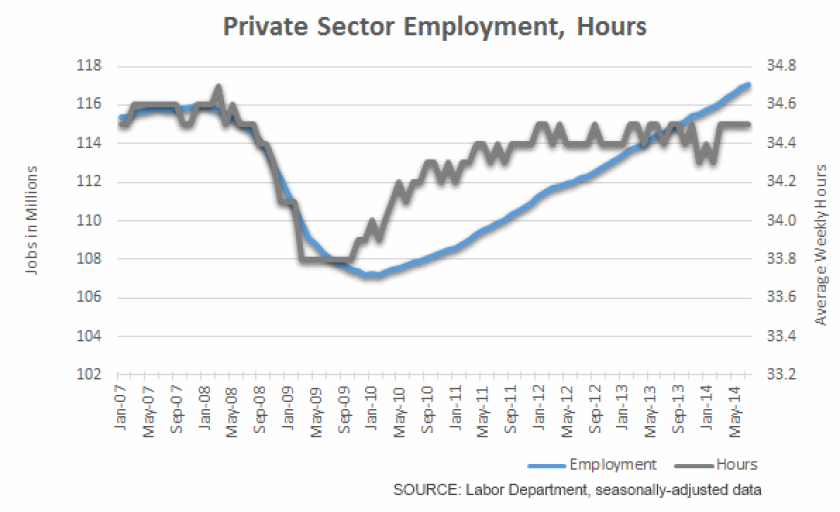Over the past three years of the recovery, the length of the U.S. workweek hasn’t budged much. The Labor Department’s most recent estimates for July indicate full and part-time employees worked an average of 34.5 hours per week. Many individual local economies, though, experienced more visible shifts. Examining the average number of hours worked at the local level helps provide cues as to both whether a region’s employers are gearing up to expand payrolls and the types of jobs being created or lost.
Private sector employees in the Houma-Bayou Cane-Thibodaux, La., metro area worked an average of 43.6 hours per week in July, the most of any locality with published Labor Department data. Not too far behind were Midland and Odessa, Texas, two areas similarly enjoying rapid growth fueled by oil industry expansion.
By contrast, the Lawrence, Kan., labor force worked a mere 25.6 hours a week on average. That’s likely attributable to the area’s large number of part-timers employed by the University of Kansas.
Average weekly hours worked is a fairly obscure measure that doesn’t receive the same scrutiny as employment tallies in the monthly jobs report. Variations in hours worked for an entire workforce, though, are akin to significant layoffs or hiring.
Nationally, a steep decline in average hours worked mirrored severe jobs losses incurred during the Great Recession. When the economy hit a recessionary trough back in 2009, the average workweek dipped below 34 hours. It then started to climb a few months before the economy began adding jobs again in 2010.

More recently, about half of local areas saw an uptick in the average weekly hours worked over the 12-month period ending in July. Data includes both full and part-time employees; those unemployed are excluded.
To a large extent, an area’s average hours worked reflects the industry makeup of its economy. Areas with higher averages support industries like the utilities sector, which recorded an average workweek of 42.5 hours in July. Those in manufacturing also tend to work longer hours – 40.9 hours compared to the private sector average of 34.5 hours.
Consider Columbus, Ind., and Macon, Ga., which both had among the longest average workweeks of any metro area last year. Manufacturing accounts for a large share of the workforce – roughly a third of total employment – in both regions.
White-collar workers generally work fewer hours. Not surprisingly, the shortest workweeks are found in the leisure and hospitality sector, where far more work part time. These employees logged only about 26 hours per week on average. Smaller areas surrounding resort towns tend to have shorter average workweeks, as do college towns.
Some workers struggling to find full-time employment end up working part time jobs for an extended period of time. The number of employees working part time for economic reasons has fallen with the recovery, but those doing so by choice has climbed.
Dean Baker, co-director of the Center for Economic and Policy Research, attributed the increase in voluntary part-timers to the Affordable Care Act. Many of them, he said, previously worked full-time jobs primarily to obtain health insurance.
Lower income earners receive greater subsidies under the law, incentivizing some to work less. The Congressional Budget Office estimated earlier this year that the total number of net hours worked will drop between 1.5 and 2 percent from 2017 to 2024. (See Appendix C here). Baker said younger adults with children, in particular, are opting to work part time more often.
“With ACA, it’s a little bit of a wild card,” Baker said. “We may see it play out in different ways.”
Varying pay structures further explain why some work much longer hours. In a Gallup survey published last week, about half of full-time salaried employees reported working 50 or more hours per week, while just 26 percent of hourly employees did so. Employers often restrict the hours of hourly workers to avoid overtime costs.
For much of the workforce, a traditional 9-to-5 schedule remains a rarity. The Gallup survey found full-time U.S. employees worked an average of 47 hours a week, with 18 percent clocking 60 or more hours.
Local Area Data
Select an area to display estimates for average weekly hours. Figures are for private sector workers employed full or part-time.Learn About Tableau










